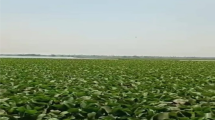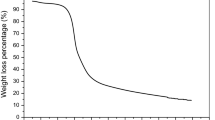Abstract
Disposing of soda sludge is one of the critical issues carbonated soft drink industries are currently experiencing. In this experiment, soda sludge was transformed into activated carbon and then used to adsorb methylene blue (MB) dye. The response surface methodology of the central composite design was used to determine the optimal conditions for each test variable, which were then used to determine the activated carbon’s optimum removal efficiency of the MB dye. The FTIR, SEM, and XRD were used to examine the physical and chemical properties of soda sludge–derived activated carbon (SSAC). The results revealed zeolites in SSAC, such as aluminophosphate, gobbinsite and (Na, tetramethylammonium)-E. The alcohols, alkenes, and aromatics are also physically found in the SSAC with a microporous structure. For MB dye removal, the optimum conditions were an initial dye concentration of 88.2 mg/L, an adsorbent dose of 1.6 g and a contact period of 40 min, with a removal efficiency of 95.74 ± 0.48%. The removal of MB dye from an aqueous solution using SSAC fits the Langmuir isotherm with an R2 value of 0.9972, indicating monolayer adsorption on a homogenous surface. With an R2 of 0.9576, the best kinetic model to explain the adsorption mechanism was pseudo-first-order, indicating that the adsorption process is more oriented toward physisorption. Each gram of SSAC can remove 52.71 mg of MB. Overall, soda sludge–derived activated carbon is an efficient and effective adsorbent in removing MB dye from an aqueous solution, with significant implications for its use in removing other pollutants from wastewater.






Similar content being viewed by others
Availability of data and materials
All data generated or analyzed in this study are included in this article.
References
Budnyak TM, Aminzadeh S, Pylypchuk IV, Sternik D, Tertykh VA, Lindström ME, Sevastyanova O (2018) Methylene blue dye sorption by hybrid materials from technical lignins. J Environ Chem Eng 6:4997–5007. https://doi.org/10.1016/j.jece.2018.07.041
Chen X, Jeyaseelan S, Graham N (2002) Physical and chemical properties study of the activated carbon made from sewage sludge. Waste Manag 22:755–760. https://doi.org/10.1016/S0956-053X(02)00057-0
Fan S, Wang Y, Wang Z, Tang J, Tang J, Li X (2017) Removal of methylene blue from aqueous solution by sewage sludge-derived biochar: adsorption kinetics, equilibrium, thermodynamics and mechanism. J Environ Chem Eng 5:601–611. https://doi.org/10.1016/j.jece.2016.12.019
Feliciano RM, Pinagawa AB, Ranoco SAV, Yu DH, Ido AL, Arazo RO (2024) Degradation of acid Red 114 dye from aqueous solution through the advanced ozonation process. Mater Circ Econ 6:8. https://doi.org/10.1007/s42824-023-00092-8
Hameed BH, Krishni RR, Sata SA (2009) A novel agricultural waste adsorbent for the removal of cationic dye from aqueous solutions. J Hazard Mater 162:305–311. https://doi.org/10.1016/j.jhazmat.2008.05.036
Jellali S, Khiari B, Al-harrasi M, Charabi Y, Al-sabahi J, Al-abri M, Usman M, Al-raeesi A (2023) Industrial sludge conversion into biochar and reuse in the context of circular economy : impact of pre-modification processes on pharmaceuticals removal from aqueous solutions. Sustain Chem Pharm 33:101114. https://doi.org/10.1016/j.scp.2023.101114
Jin H, Arazo R, Gao J, Capareda S, Chang Z (2014) Leaching of heavy metals from fast pyrolysis residues produced from different particle sizes of sewage sludge. J Anal Appl Pyrolysis 109:168–175. https://doi.org/10.1016/j.jaap.2014.06.016
Karam AA (2021) The Brand Impact on Culture: Case of Coca Cola Cultural Issues in India. Lecture Notes in Networks and Systems, pp. 551–570. https://doi.org/10.1007/978-3-030-69221-6_42
Karim E, Dhar K, Hossain T (2018) Decolorization of textile reactive dyes by bacterial monoculture and consortium screened from textile dyeing effluent. J Genet Eng Biotechnol 16:375–380. https://doi.org/10.1016/j.jgeb.2018.02.005
Li Z, Yu D, Wang X, Liu X, Xu Z, Wang Y (2024) A novel strategy of tannery sludge disposal – converting into biochar and reusing for Cr (VI) removal from tannery wastewater. J Environ Sci 138:637–649. https://doi.org/10.1016/j.jes.2023.04.014
Marchitto TM, Farmer JR (2023) Nutrient proxies. In: Reference Module in Earth Systems and Environmental Sciences. pp. 1732–1740. https://doi.org/10.1016/B978-0-323-99931-1.00051-9
Miyah Y, Lahrichi A, Idrissi M, Khalil A, Zerrouq F (2018) Adsorption of methylene blue dye from aqueous solutions onto walnut shells powder: equilibrium and kinetic studies. Surf Interfaces 11:74–81. https://doi.org/10.1016/j.surfin.2018.03.006
Mushtaq S, Jamil F, Hussain M, Inayat A, Majeed K, Akhter P, Khurram SM, Shanableh A, Kim MY, Park Y-K (2024) Utilizing sludge-based activated carbon for targeted leachate mitigation in wastewater treatment. Environ Res 249:118326. https://doi.org/10.1016/j.envres.2024.118326
Nasuha N, Hameed BH, Din ATM (2010) Rejected tea as a potential low-cost adsorbent for the removal of methylene blue. J Hazard Mater 175:126–132. https://doi.org/10.1016/j.jhazmat.2009.09.138
Nelson AK (1964) Hydrolysis rates of solutions of pyrophosphoric acid. J Chem Eng Data 9:357. https://doi.org/10.1021/je60022a012
Nuanhchamnong C, Kositkanawuth K, Wantaneeyakul N (2022) Granular waterworks sludge-biochar composites: characterization and dye removal application. Results Eng 14:100451. https://doi.org/10.1016/j.rineng.2022.100451
Oke N, Mohan S (2022) Development of nanoporous textile sludge based adsorbent for the dye removal from industrial textile effluent. J Hazard Mater 422:126864. https://doi.org/10.1016/j.jhazmat.2021.126864
Pagalan E, Sebron M, Gomez S, Salva SJ, Ampusta R, Macarayo AJ, Joyno C, Ido A, Arazo R, Jane S, Ampusta R, Joy A, Joyno C, Ido A, Arazo R, Salva SJ, Ampusta R, Macarayo AJ, Joyno C, Ido A, Arazo R (2020) Activated carbon from spent coffee grounds as an adsorbent for treatment of water contaminated by aniline yellow dye. Ind Crop Prod 145:111953. https://doi.org/10.1016/j.indcrop.2019.111953
Pathania D, Sharma S, Singh P (2017) Removal of methylene blue by adsorption onto activated carbon developed from Ficus carica bast. Arab J Chem 10:S1445–S1451. https://doi.org/10.1016/j.arabjc.2013.04.021
Pramudita D, Iskandar I, Indarto A (2018) Nano-enhanced materials for reclamation of mine spoils. In: Bio-Geotechnologies for Mine Site Rehabilitation. Elsevier Inc., Indonesia, pp 201–214. https://doi.org/10.1016/B978-0-12-812986-9.00012-9
Rajeswari TR, Sailaja N (2014) Impact of heavy metals on environmental pollution. J Chem Pharm Sci 3:175–181
Ramakrishna S, Jose R (2021) Reimagine materials for realizing SDG11: sustainable cities and communities. Mater Circ Econ 3:10–11. https://doi.org/10.1007/s42824-021-00041-3
Ravindiran G, Sundaram H, Marimuthu E, Ramasamy S, Nabil A (2023) Removal of azo dyes from synthetic wastewater using biochar derived from sewage sludge to prevent groundwater contamination. Urban Clim 49:101502. https://doi.org/10.1016/j.uclim.2023.101502
Rondina JD, Ymbong D, Cadutdut MJ, Nalasa JR, Paradero J, Mabayo VI, Arazo R (2019) Utilization of a novel activated carbon adsorbent from press mud of sugarcane industry for the optimized removal of methyl orange dye in aqueous solution. Appl Water Sci 9(181):1–12. https://doi.org/10.1007/s13201-019-1063-0
Ropp RC (2013) Group 14 (C, Si, Ge, Sn, and Pb) Alkaline Earth Compounds. In: Encyclopedia of the Alkaline Earth Compounds, pp 351–480. https://doi.org/10.1016/B978-0-444-59550-8.00005-3
Saner A, Carvalho PN, Catalano J, Anastasakis K (2022) Renewable adsorbents from the solid residue of sewage sludge hydrothermal liquefaction for wastewater treatment. Sci Total Environ 838:156418. https://doi.org/10.1016/j.scitotenv.2022.156418
Simonin J (2016) On the comparison of pseudo-first order and pseudo-second order rate laws in the modeling of adsorption kinetics. Chem Eng J 300:254–263. https://doi.org/10.1016/j.cej.2016.04.079
Singh S, Sidhu GK, Singh H (2017) Removal of methylene blue dye using activated carbon prepared from biowaste precursor. Indian Chem Eng 61:28–39. https://doi.org/10.1080/00194506.2017.1408431
Tareq R, Akter N, Azam S (2019) Biochars and biochar composites: low-cost adsorbents for environmental remediation. In: Biochar from Biomass and Waste. Elsevier Inc., pp 169–209. https://doi.org/10.1016/B978-0-12-811729-3.00010-8
Tian Q, Jiang Y, Liu D, Dai Y, Zhao B, Zhang T, Qiu F (2024) Recycling waste dredged sludge into bifunctional coating for one-step separation of multitasking dye contaminated oil/water emulsions. J Ind Eng Chem. https://doi.org/10.1016/j.jiec.2024.01.008
Uçal GO, Mahyar M, Tokyay M (2018) Hydration of alinite cement produced from soda waste sludge. Constr Build Mater 164:178–184. https://doi.org/10.1016/j.conbuildmat.2017.12.196
Wong S, Atiqah N, Yac N, Ngadi N, Hassan O, Inuwa IM (2018) From pollutant to solution of wastewater pollution: synthesis of activated carbon from textile sludge for dye adsorption. Chin J Chem Eng 26:870–878. https://doi.org/10.1016/j.cjche.2017.07.015
Xie K, Zhang H, Sun S, Gao Y (2019) Functions of boric acid in fabricating TiO2 for photocatalytic degradation of organic contaminants and hydrogen evolution. Mol Catal 479:110614. https://doi.org/10.1016/j.mcat.2019.110614
Acknowledgements
The authors would like to thank the College of Engineering and Technology of the University of Science and Technology of Southern Philippines – Claveria for the support.
Author information
Authors and Affiliations
Contributions
CG contributed to the conceptualization, methodology, formal analysis, investigation, resource acquisition, and original draft writing of the project. MCU was involved in the conceptualization, methodology, formal analysis, investigation, and resource acquisition. TCC played a role in the conceptualization, methodology, formal analysis, investigation, and resource acquisition. JA helped in the conceptualization, methodology, formal analysis, investigation, and resource acquisition. IKB assisted in the conceptualization, methodology, formal analysis, investigation, and resource acquisition. EVMG was instrumental in the conceptualization, methodology, formal analysis, investigation, and resource acquisition. CJ was responsible for the formal analysis and supervision of the project. EP assisted in the investigation and supervision. RO oversaw project administration, provided supervision, and contributed to the writing, reviewing, and editing of scientific works.
All authors have contributed to the study from conceptualization, laboratory experimentation, data gathering, analysis, and interpretation. All authors read and approved the final manuscript.
Corresponding author
Ethics declarations
Conflict of interest
The authors declare no competing interests.
Additional information
Publisher's Note
Springer Nature remains neutral with regard to jurisdictional claims in published maps and institutional affiliations.
Rights and permissions
Springer Nature or its licensor (e.g. a society or other partner) holds exclusive rights to this article under a publishing agreement with the author(s) or other rightsholder(s); author self-archiving of the accepted manuscript version of this article is solely governed by the terms of such publishing agreement and applicable law.
About this article
Cite this article
Gonzales, C., Ubalde, M.C., Carpentero, T.C. et al. Efficiency of Soda Sludge–Derived Activated Carbon in the Removal of Methylene Blue Dye from an Aqueous Solution. Mater Circ Econ 6, 12 (2024). https://doi.org/10.1007/s42824-024-00103-2
Received:
Revised:
Accepted:
Published:
DOI: https://doi.org/10.1007/s42824-024-00103-2




